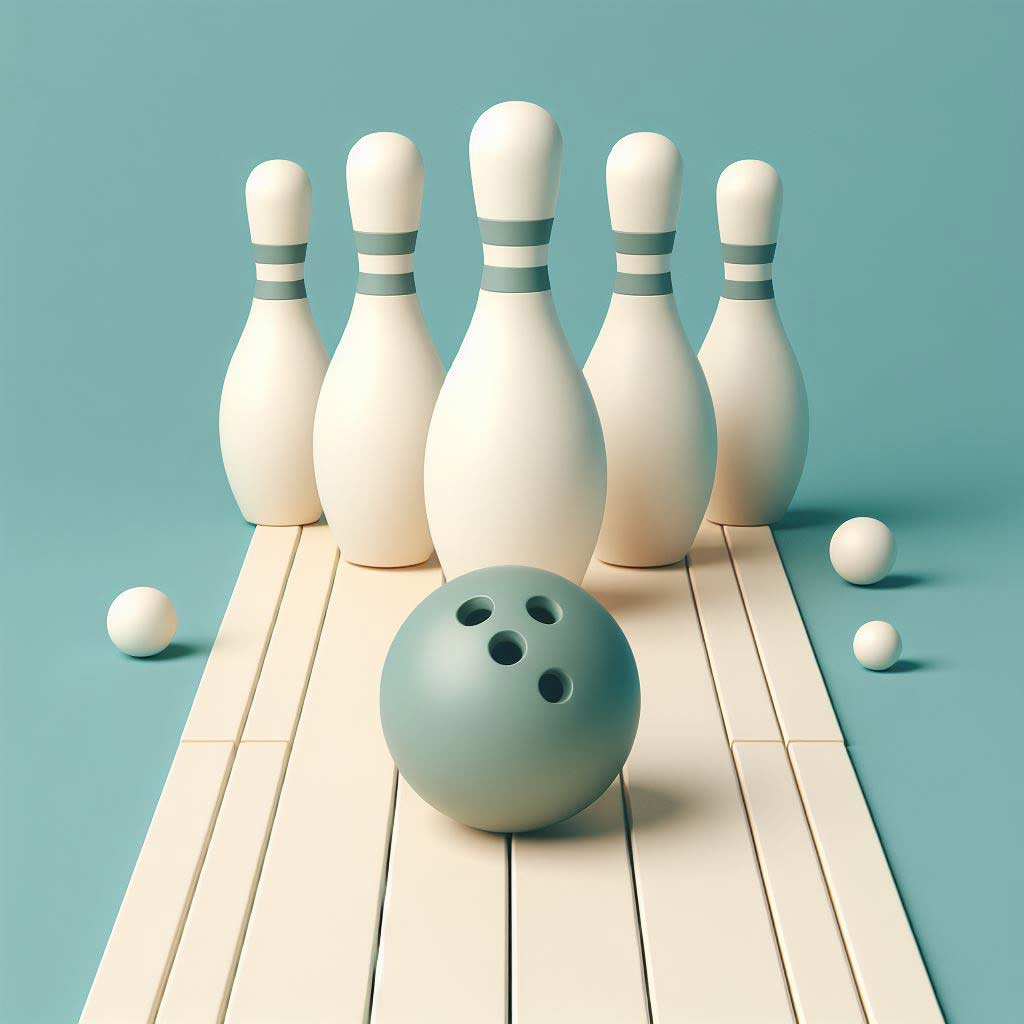For many bowling enthusiasts, the thrill of knocking down all 10 pins with a single roll is the ultimate goal. But there’s a lesser-known variant of the sport that offers a unique challenge and an entirely different bowling experience – duckpin bowling.
Unlike the familiar 10-pin format, duckpin bowling features smaller balls and pins, creating a gameplay that is both more accessible and more unpredictable.
At the heart of the duckpin bowling experience are the specialized duckpin bowling lanes. These compact, purpose-built alleys are distinctly different from their 10-pin counterparts, both in design and function.
If you’re curious to learn more about this niche but fascinating bowling format, then you’ve come to the right place. In this comprehensive guide, we’ll dive deep into the world of duckpin bowling lanes, exploring their unique features, construction, and future outlook.
What is a Duckpin Bowling Lane?
To the uninitiated, a duckpin bowling lane may appear similar to a traditional 10-pin lane. However, a closer inspection reveals some key differences.
Duckpin lanes are significantly shorter, typically measuring 60 feet in length, compared to the standard 10-pin lane length of 60-62 feet. This compact design is a reflection of the sport’s origins, which trace back to the late 19th century when duckpin bowling first emerged as a variation of its better-known counterpart.
The width of a duckpin lane is also narrower, at just 42 inches, compared to the 60-inch width of a 10-pin lane. This reduced width, combined with the shorter length, creates a more intimate and challenging playing environment for duckpin bowlers.
Another distinguishing feature of duckpin lanes is the specialized bowling balls and pins used in the game. Duckpin balls are significantly smaller than traditional 10-pin balls, measuring just 4.75 inches in diameter and weighing a maximum of 3 pounds, 6 ounces.
The pins themselves are also diminutive, standing just 15 inches tall and with a diameter of 5.75 inches – roughly half the size of 10-pin bowling pins.
Anatomy of Duckpin Bowling Lanes
To fully understand the unique characteristics of a duckpin bowling lane, let’s take a closer look at its key components:
- Approach Area: The approach area is the section of the lane where bowlers take their stance and initiate their delivery. In duckpin bowling, this area is typically shorter than in 10-pin bowling, measuring around 15 feet in length. The reduced approach length is a concession to the game’s origins, where bowlers would often deliver the ball while standing in one spot.
- Foul Line: The foul line is the demarcation point that separates the approach area from the lane itself. Crossing the foul line during delivery results in a foul, and the subsequent frame being scored as a zero. In duckpin bowling, the foul line is the same 60-inch width as the lane.
- Gutters: The gutters on a duckpin lane serve the same purpose as their 10-pin counterparts – to catch any balls that stray too far from the center of the lane. However, the duckpin gutters are narrower, typically measuring 6 inches in width, compared to the 8-10 inch gutters found on standard 10-pin lanes.
- Pin Deck: The pin deck is the area at the far end of the lane where the pins are set up. In duckpin bowling, the pin deck is slightly smaller than in 10-pin, with a diameter of 42 inches. The pins are arranged in a classic equilateral triangle, with the center pin standing 34 inches from the foul line.
- Scoring Area: The scoring area is the section of the lane where the pins are knocked down and the bowler’s score is tallied. Duckpin scoring is similar to 10-pin bowling, with a strike awarded for knocking down all 10 pins with the first roll, and a spare earned for clearing all pins in two rolls.
Lane Construction and Materials
Duckpin bowling lanes, like their 10-pin counterparts, are built using a variety of specialized materials and construction techniques. The foundation of a duckpin lane is typically a concrete slab, which provides a sturdy and level base for the rest of the components.
Laid atop the concrete foundation is a layer of wood, usually maple or a similar hardwood, which serves as the playing surface. This wood surface is then coated with a specialized lane finish, often a polyurethane-based product, to create a smooth and consistent playing surface.
One key difference in duckpin lane construction is the use of a slightly different wood type for the approach area. While the main playing surface may be maple, the approach area is often constructed using a softer wood, such as pine or fir, to provide better traction and grip for bowlers.
Proper maintenance and care of a duckpin bowling lane is essential to ensure optimal playing conditions. This includes regular oiling and conditioning of the lane surface, as well as addressing any wear or damage to the wood or other components.
Duckpin Lane Specifications and Regulations
Duckpin bowling, like its 10-pin counterpart, is governed by a set of standards and regulations set forth by various governing bodies. These rules and specifications ensure consistency and fairness across all duckpin bowling facilities and competitions.
When it comes to the physical dimensions of a duckpin bowling lane, the regulations are as follows:
- Lane Length: 60 feet
- Lane Width: 42 inches
- Approach Area Length: 15 feet
- Gutter Width: 6 inches
- Pin Deck Diameter: 42 inches
- Pin Height: 15 inches
- Pin Diameter: 5.75 inches
- Ball Diameter: 4.75 inches
- Ball Weight: Maximum 3 pounds, 6 ounces
These standardized specifications help to create a level playing field for duckpin bowlers, ensuring that the game can be enjoyed and played consistently across different venues and regions.
Challenges and Considerations in Duckpin Lane Design
While the compact design of duckpin bowling lanes may seem straightforward, there are several unique challenges and considerations that go into their construction and maintenance.
One of the primary challenges is the limited space available for the lane itself. With a width of just 42 inches, duckpin lanes require a more efficient use of space compared to their 10-pin counterparts. This can sometimes lead to innovative lane configurations, such as side-by-side or stacked layouts, to maximize the number of lanes within a given facility.
Another consideration is the specialized equipment required for duckpin bowling. From the smaller balls and pins to the unique oiling patterns, duckpin lanes demand a different approach to maintenance and upkeep.
Ensuring the proper balance of oil distribution and lane surface conditions is crucial for providing a fair and consistent playing experience for bowlers.
Additionally, the shorter approach area of a duckpin lane can pose challenges for bowlers, as they have less room to build up momentum and rhythm before releasing the ball. Designers must carefully consider the layout and dimensions of the approach area to optimize both performance and safety.
Despite these challenges, duckpin bowling lane designers have found creative solutions to overcome these obstacles. For example, some facilities have incorporated adjustable approach areas or specialized ball return systems to enhance the overall duckpin bowling experience.
The Future of Duckpin Bowling Lanes
As the sport of duckpin bowling continues to evolve, so too will the design and construction of the lanes themselves. While duckpin bowling may not enjoy the same widespread popularity as its 10-pin counterpart, there is a dedicated and passionate community of duckpin enthusiasts who are driving innovation in the field.
One area of potential growth is the incorporation of modern technologies and materials into duckpin lane design. This could include the use of advanced coatings or synthetic surfaces that offer improved durability and consistency, or the integration of sensor-based systems to provide real-time data and feedback to bowlers and lane operators.
Additionally, the growing interest in retro and nostalgia-driven leisure activities may contribute to a renewed appreciation for the unique charm and character of traditional duckpin bowling lanes.
As more people discover the thrill of this niche bowling format, there may be an increased demand for the preservation and restoration of historic duckpin facilities.
Ultimately, the future of duckpin bowling lanes will be shaped by a combination of technological advancements, shifting consumer preferences, and the continued dedication of the duckpin bowling community.
Whether it’s through the development of cutting-edge lane designs or the revival of cherished vintage alleys, the unique allure of duckpin bowling is sure to captivate and inspire generations of enthusiasts to come.
Conclusion
Duckpin bowling lanes are a unique and fascinating aspect of the sport, with a rich history and a dedicated following of enthusiasts. From their compact dimensions to their specialized equipment, these compact alleys offer a distinctly different bowling experience that is both challenging and rewarding.
As you’ve learned in this comprehensive guide, the design and construction of duckpin bowling lanes involve a range of specialized considerations, from material selection to regulatory requirements.
And while the future of the sport may be uncertain, the enduring appeal of duckpin bowling suggests that these unique lanes will continue to capture the imagination of bowlers for years to come.
So, whether you’re a seasoned duckpin enthusiast or a curious newcomer, we hope this guide has provided you with a deeper understanding and appreciation for the intricate world of duckpin bowling lanes. So why not gather a group of friends, lace up your shoes, and discover the thrill of this one-of-a-kind bowling experience for yourself?





